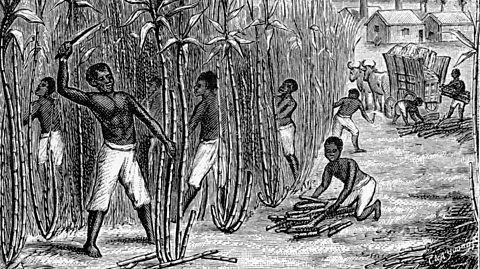What were slave fortresses?
 Image source, ALAMY
Image source, ALAMYQuick version
European powers began trading for gold and other commodities in West African from the 15th Century:
As rival European powers fought for control of trade, trading posts were expanded into heavily defended fortresses.
As trade in enslaved people developed, fortresses were used to hold captives until they were sold to passing ships.
Conditions in slave fortresses were terrible:
- captured people were branded as property
- men and women were separated and kept in dark, unsanitary conditions
- they were given little food to keep them subdued
- many died from exposure to new diseases and bad treatment
- attempts at rebellion were met with brutal punishment or death
Some people were held in fortresses for months before being transferred to ships and transported to the Americas.
Learn in more depth
How did European trade with West Africa begin?
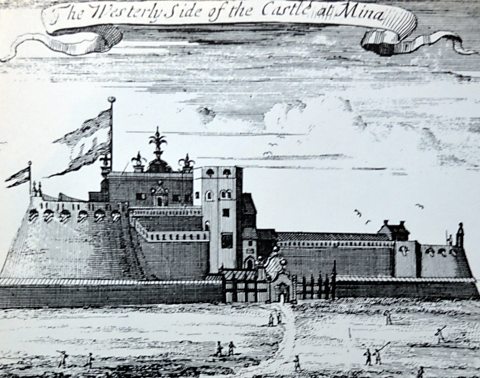 Image source, ALAMY
Image source, ALAMYInitially, European trade with Africa did not specialise in enslaved people.
In the 15th Century, Portugal developed trade with West Africa. Portuguese traders began buying gold from African societies along what became known as the Gold Coast.
They built forts such as S√£o Jorge da Mina ('St George of the Mine'), later known as Elmina, as trading bases. These fortified structures were designed to show strength and to control trade. They contained large stores where commodities were kept.
By the 17th Century, other European powers, including the Dutch, French and British, were developing trading links with African societies. As well as gold, other metals and timber, they began trading goods for captive people who were transported into slavery in the Americas.
 Image source, ALAMY
Image source, ALAMYHow did slave fortresses develop?

Profitable trade in West Africa led Europeans to set up permanent trading camps or forts on the West African coast with the permission of the local African leaders.
These trading posts functioned as small towns with housing areas for the Europeans to live in and well-defended warehouses where the commodities they traded were stored.
Competition for trade between rival European powers brought changes to these settlements:
- forts were expanded
- stronger, larger fortresses were built
- these were defended with heavy walls and cannons aimed out to sea to prevent attacks from raiding ships or pirates
- fortresses were fought over and many changed ownership several times
For example:
- the Dutch took control of Elmina
- Cape Coast Castle in modern Ghana was built by Swedish merchants in the mid 1600s, later captured by the Danes, and then by the English in 1662
When African trade became dominated by buying and selling enslaved people, store rooms became dungeons where people were held as prisoners.

What happened to people arriving at a slave fortress?
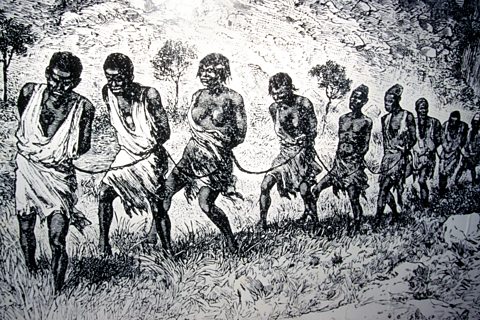 Image source, ALAMY
Image source, ALAMYInitially most Africans captured to be sold to slave traders were from coastal areas of Western Africa.
Later, when the population of coastal areas declined, slavers were forced to move further inland to capture Africans.
These captured people had to endure a long march back to the coast to be imprisoned in the slave fortresses. Often they were chained together in groups called coffles.
On arrival at the slave fortresses, the captured Africans were processed:
- males and females were separated
- families were split up
- prisoners were inspected by a surgeon
- the healthiest people were selected and bought
- healthy captives were branded on the chest with a hot iron - this aimed to stop African traders from trying to switch sick captives with healthy enslaved people who had been bought
- captives would then be taken to holding cells (often dungeons) to await the arrival of European slave ships
 Image source, ALAMY
Image source, ALAMYWhat were conditions like in a slave fortress?
 Image source, ALAMY
Image source, ALAMYConditions in slave fortresses were terrible:
- enslaved people lived in cramped, poorly-ventilated dungeons where there was little room to lie down
- the quality of food was poor and enslaved people were kept hungry to keep them weak and compliant
- there was no sanitation and illness and disease were common.
- poor living conditions led to deaths from tropical illness such as malariaA disease spread by mosquito bites in tropical climates. Malaria is curable but can be life-threatening. and Yellow FeverA viral disease spread by mosquitos. It causes illness and fever and can cause damage to the liver and kidneys..
- captive African people had little resistance to European diseases that they had not encountered before. Many died from these illnesses.
It must not be concluded that the slaves were unaffected by the local disease environment. Not only did they fall victim to their indigenous diseases but they were infected by the new ones brought by the Europeans.
– 'General History of the Caribbean: Volume III The slave societies of the Caribbean', editor Franklin W. Knight
Conditions for the Europeans in the fortresses were much better. Some fortresses had gardens which provided fresh fruit and vegetables, and there were other facilities such as churches.
However, the Europeans too were exposed to new diseases for which they had little or no resistance:
Between 1684 and 1732, for example, the average annual death toll for men in the [Royal Africa] Company's service on the Gold Coast was 27%.
– 'General History of the Caribbean: Volume III The slave societies of the Caribbean', editor Franklin W. Knight.
 Image source, ALAMY
Image source, ALAMYAbuse and punishment in slave fortresses
Violence and abuse in the slave fortresses was common.
- captive African people were whipped and beaten for things they did wrong
- captive women and girls faced sexual assaults and rape
- people were put in punishment cells for rebelling - in severe cases they could be deprived of food and water and left to die
Enslaved people often had to endure these conditions for months before they were sold to European slave traders.
How did captive people leave slave fortresses?
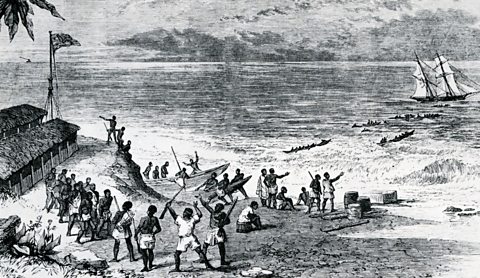 Image source, ALAMY
Image source, ALAMYFor African people who survived months of imprisonment in the dungeons of the slave fortresses the only way out was to be sold on to European slave traders,
Some traders would travel along the coast, stopping off at different slave forts picking up a cargo of captive people until they had a full load. Other traders would take on a full cargo at one fortress
Enslaved people would be led out of the fort through an gateway called the ‘door of no return’ and onto awaiting boats that would take them from Africa forever.
After surviving the cramped and terrible conditions of the dungeons, the enslaved Africans bound for the plantations of the Americas or the Caribbean had to endure weeks in the cargo holds of the slaver ships. Many more would die on the journey.
It is thought around 6 million Africans died either in captivity in slave fortresses or on board slave ships travelling to the Americas.
 Image source, ALAMY
Image source, ALAMYWhat impact did slave fortresses have?
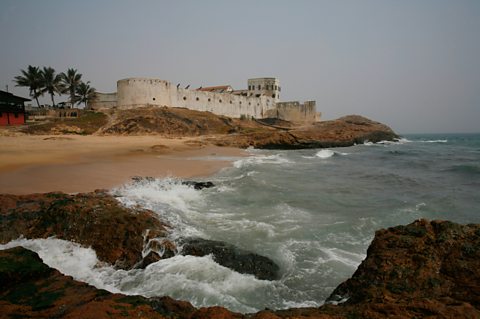 Image source, ALAMY
Image source, ALAMYWhen European traders set up trading posts in West Africa, this altered the geography of trade routes operating in Africa.
- commerce with the world outside Africa changed from overland to sea
- coastal villages whose main trades had been fishing and salt production became ports and trading posts
- slave fortresses and the trade in enslaved people became major sources of income in coastal areas
These permanent bases – often operating for over a hundred years – played a role in the eventual European colonisation of large parts of Africa.
By that time, Africa was seen as a great source of wealth for European nations and important to their success as global powers.
 Image source, ALAMY
Image source, ALAMYQuiz
Recap what you have learned
- Slavery existed in African societies prior to European traders.
- The transatlantic trade in enslaved people increased African slavery.
Due to the huge demand for an enslaved labour force to work on Caribbean and American plantations, European traders set up permanent bases in West Africa. These became known as slave fortresses.
- Millions of Africans were captured and sold through these European slave fortresses.
- Millions of enslaved Africans died in captivity or on board European slave ships en route to the New World.
West African societies change due to the trade in enslaved people. The wealth to be made from trading with the Europeans made slavery a major industry for some West African regions.
Warfare was common between African regions and prisoners of war were sold to the European traders.
More on Trade in enslaved African people
Find out more by working through a topic
- count5 of 10

- count6 of 10
